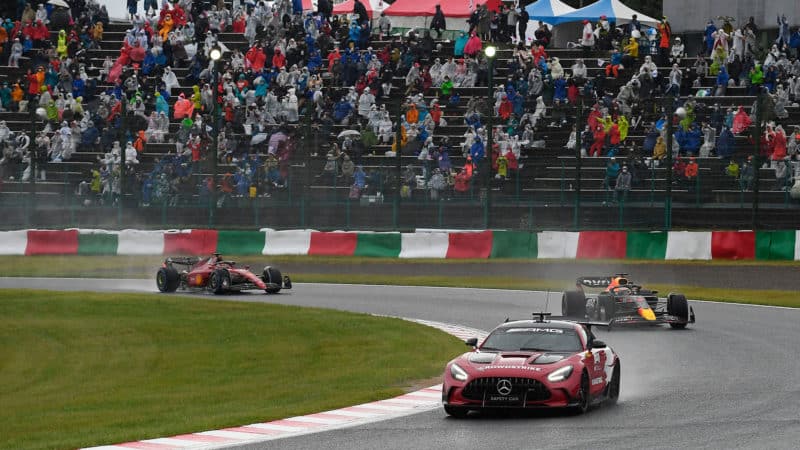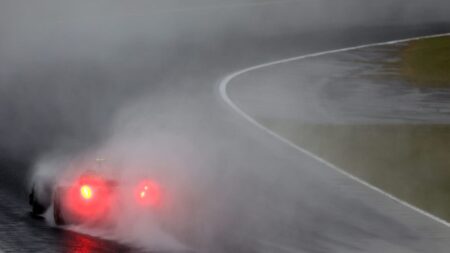Leaving that to the FIA’s special enquiry, the points confusion was entirely understandable given that not only race broadcasters but the entire paddock ‘got it wrong.’ And for the first time in F1 history, drivers were awarded full points for a race that had not completed 75% distance.
It’s perfectly true that the wording of the rule in question is not new and says, “If a race is suspended and cannot be resumed… half points will be awarded if the leader has completed more than two laps but less than 75% of the original race distance, and full points will be awarded if the leader has completed 75% or more of the original race distance.”
The important bit is “cannot be resumed.” The Japanese GP was resumed, so none of it applies.
You can argue that it’s all perfectly clear, nobody read the rule book properly and the FIA got it completely right. In fact, after the aggravation following Abu Dhabi ’21, it was imperative that they did everything by the book.
But there are a couple of problems with that. First, after the Spa debacle in 2021, where half points were awarded after three laps behind a safety car with no actual racing, a new regulation was introduced this year, intended to avoid a repeat and to provide points allocation commensurate with race distance completed.
The more complex rule said:
• For any points to be allocated, a minimum two laps must be completed by the leader without safety car or VSC intervention.
• If at least two laps but less than 25% scheduled distance was completed, points would be 6-4-3-2-1 to the first five finishers.
• If between 25-50% was completed, the points allocation changed to 13-10-8-6-5-4-3-2-1 for the first nine.
• If at least 50% distance but less than 75%, it became 19-14-12-9-8-6-5-3-2-1 to the top 10,
• Anything over 75% distance brought full points.
The intent made sense, but only if the “cannot be resumed” part of was removed, which it wasn’t. Otherwise, taking things to extremes, you could have had a situation at Suzuka where the rain delay lasted long enough that only three laps were possible before the race timed out and yet full points would still have been awarded. Clearly not the intention and a total nonsense.

Rain delay and then safety car restart meant that a reduced-length race was inevitable
Grand Prix Photo
And so, as soon as it became evident that the rain delay had got to the point where a full race was impossible within the three-hour time frame, teams, commentators and producers all started to take note of the anticipated number of laps and the key milestones – laps 14, 27 and 40.
The potential banana skins were thought to be a second red flag on laps 15 or 28 (41 was never going to be reached), which would have taken the classification back to the previous column of points allocation. And which the Law of Sod dictated would probably happen!
Muddying the picture somewhat, were sporadic on-screen graphics throughout the race showing full points. It was assumed by all of the British-based broadcasting outlets at any rate, that this was an error.
Even when Charles Leclerc was penalised, Red Bull did not think that Verstappen was champion.
"Champion? Not Champion?" 🤔
Even Max had to be convinced! 😃#JapaneseGP #F1 pic.twitter.com/kiJXb283RN
— Formula 1 (@F1) October 9, 2022
Christian Horner said, “I think it’s a mistake that wasn’t included after the issues in Spa last year, that the regulations obviously haven’t been mopped up. We were under the strong impression that only with 75% of the race, full points would be scored. We felt we were going to be one point short.”
McLaren’s team principal, Andreas Seidl, added, “How the points were awarded today wasn’t what we all had in mind (at the meeting about revisions). That wasn’t the intention from the FIA or the team side. But in the end, it seems like we all overlooked this loophole and therefore we are all responsible for that. It means we must try to do, together, a better job next time.”
Very shortly after the end of the race, the FIA’s media delegate, Tom Wood, sent out a helpful text explaining that reduced points (article 6.5) only applied in the event of race suspension that cannot be resumed, and so it was full points.
It wasn’t simply a case of not having read the rulebook
Some in the broadcasting world wondered why that could not have happened sooner, given they’d been broadcasting fake news for the past hour, but that does not fall on Tom Wood. He’s not listening to broadcasts and is on-site concerned primarily with the needs / questions of around 250 journalists. You do wonder though, why someone in F1’s broadcast unit didn’t find a way to get the message through.
Complicating it further was the race timing-out after 28 laps of the scheduled 53 laps. It could therefore be interpreted as having been suspended once again rather than completed, bringing the reduced points scenario into play – the interpretation of most of the paddock. It wasn’t simply a case of not having read the rulebook.
For a bit of historical perspective, only six races in F1 history have resulted in half points being awarded: Spain and Austria ’75 (when Vittorio Brambilla was so excited at seeing the chequered flag that he crashed on the slowdown lap!), the famous ’84 Monaco when Alain Prost, frantically pointing at the rainy sky as Ayrton Senna reeled him in, succeeded in getting the race stopped and cost himself a world title by scoring four and a half points for the win instead of six for finishing second to Senna (He lost the championship to McLaren team-mate Niki Lauda by half a point…). Then there was the shortened 14-lap ’91 Australian GP, Malaysia 2009, and Spa last year.

Ayrton Senna won the shortened 1991 Australian GP at Adelaide
Grand Prix Photo
Of all those races that have been red-flagged and restarted but not gone the full scheduled distance, none have run less than the requisite 75% for full points. The closest to it was Monza ’78 after the first-lap pile-up that ultimately claimed the life of Ronnie Peterson. Under the threat of darkness, it ran 40 of the scheduled 52 laps (76.9%).
The others were: Detroit ’82 (96.8%), Britain ’84 (93.8%), Mexico ’87 (92.6%), San Marino ’89 (95%), France ’92 (95.8%), Japan ’94 (94%), France ’98 (98.6%), Spa, ’01 (81.8%) and Monaco ’22 (82%).
In that regard, last weekend’s full points 52.8% distance Suzuka race was unique in F1 history. Another box ticked by Max Verstappen. Not that he’ll care!


